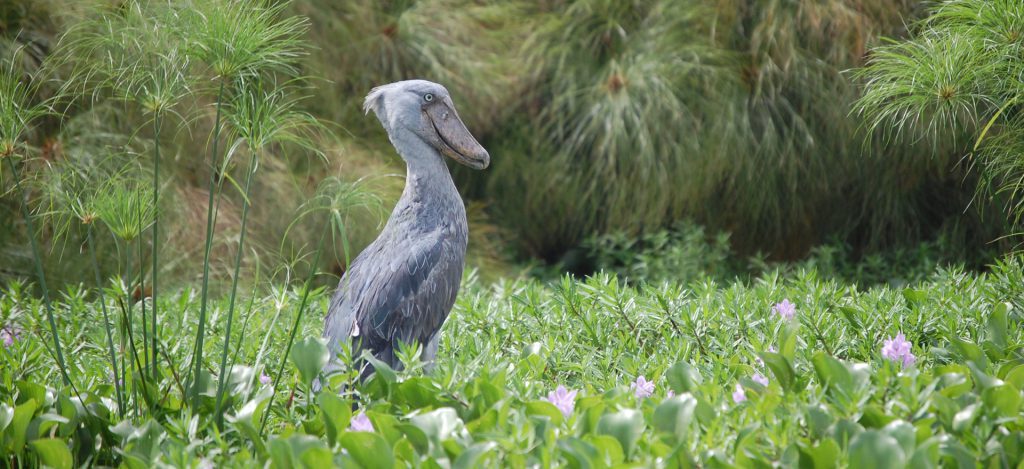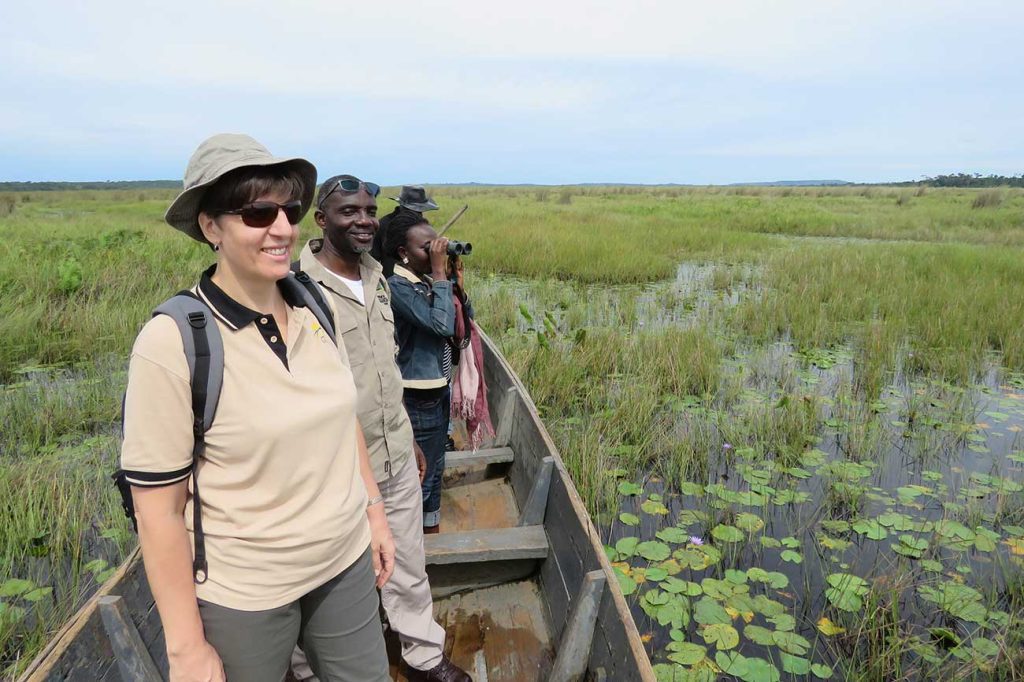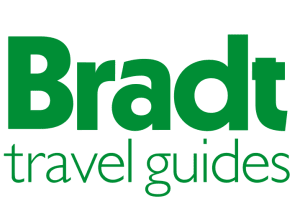DISCOVER UGANDA
Shoebill Trekking Tour in Mabamba Swamp.
Shoebill Trekking Tour in Mabamba Swamp: Mabamba Wetland is well-known for its Shoebill, Uganda’s most sought-after bird among birdwatchers. Non-bird watching tourists are also drawn to the Shoebill due to its unusual appearance and large size. The unique bird can only be found in a few areas in Uganda, and Mabamba Swamp is the most accessible and trustworthy, with the highest odds of viewing the Shoebill in Uganda, if not Africa. Mabamba Swamp is abundant in lungfish, named “mamba” in local language, a preferred meal of the Shoebill. However, the lungfish is also a popular target for local fisherman, putting it in conflict with the Shoebill.
But this is not so far-fetched because the Shoebill feeds on lungfish, and the fish will flee wherever the Shoebill goes. Seeing a Shoebill when going out to fish in the marsh was a terrible omen for the fisherman. They hunted and killed the Shoebills, causing a fall in their numbers and nearly driving them extinct in the marsh.
The Shoebill was given some protection once the marsh was designated a Ramsar reserve in 2006. However, bird observation on the marsh enlightened the fishermen and community. The fishermen make a lot of money renting out their boats to birdwatchers, and some of them have even been educated in birding and guiding.
The fishermen now guard the Shoebill, such that when they go fishing and encounter a Shoebill, they walk away from it so as not to harm it and will gladly tell tourists where to observe it. Mabamba Wetland is estimated to be home to roughly 12 Shoebills.
Shoebill Facts you should know
Uganda’s Mabamba Swamp is one of the places to see the prehistoric and sought-after shoebill stork. The shoebill stork is a single bird that may reach 150cm in height, 24cm in length, 20cm in breadth, 14 pounds in weight, and a wingspan of 230cm to 260cm. The shoebill stork eats a variety of fish, lizards, frogs, turtles, water snakes, baby crocodiles, snails, and rodents. The shoebill stork is frequently observed floating on plants or standing motionless in water with its mouth pointing down, searching for food.
The female shoebill stork lays one to three eggs, and both parents share incubation chores for several months before the young hatch. When the chicks hatch, the moms feed them until they can find their own food. They begin flying at 3 months and mature after 3 to 4 years.

How are shoebill trekking tours in Mabamba Swamp Conducted?
Shoebill trekking tours in Mabamba Swamp are done from a motorized wooden canoe/boat. There are plenty of boats available, and local riders are happy to take you to view the Shoebill. When you get inside the boat, the first bird you should search for is the Shoebill. Fishermen that go out early in the morning to discover what they captured in their nets might occasionally provide information about where they observed the Shoebill.
Otherwise, it’ll be a game of looking in the recognized meadows where the Shoebill enjoys hunting. Morning is the ideal time to watch the Shoebill because it stalks lungfish by staying stationary for lengthy periods of time, even hours, until one unlucky fish crosses its path. Later in the day, when it gets hot, the Shoebill rests by extending its wings and sitting amid the grass, making it difficult to detect. It is also observed soaring high in the sky to cool down.
After witnessing the Shoebill, proceed with typical birding by wading through dense papyrus and grasses in the many water canals leading to Lake Victoria. Purple Swamphen, African Marsh Harrier, African Darter, Common Squacco Heron, Purple Heron, Long-tailed Cormorant, Northern Brown-throated Weaver, Yellow-billed Duck, and Malachite Kingfisher are some water birds not to be missed. The pleasant walk a pathway that runs along the marsh can round off your birding trip to Mabamba and add to your list of field species. After returning from the boat ride on Mabamba marsh, use this route that begins on your left right before the exit.
The trail runs alongside the marsh, through cultivations and bushland, and past a sparse eucalyptus tree plantation that can yield some interesting forest species. Because the route is rather extensive, you may walk for a couple of hours until you’ve had enough. Rufous-napped Lark, Sooty Chat, Grassland Pipit, Red-bellied Paradise-Flycatcher, Lizard Buzzard, cuckoos, weavers, scrub-robins, and sunbirds are among the common birds.
When is the best time to see the shoebill in Mabamba Swamp?
The best time to see the Shoebill in Mabamba swamp is early morning, say 7 a.m., before there is more activity on the wetland. By this time, the Shoebill is hunting for lunch fish, which it does by standing in one place for a long time or even hours looking out in the water waiting for fish to cross so it scoops it with the big strong shoe-like bill that instantly breaks the fish. Birding in Mabamba marsh is best done between September and March, when you may see a variety of migratory bird species from Europe


How to get to Mabamba Swamp?
The marsh is located in Kasanje, Kamengo, and Mpigi sub-counties and can be reached through Kampala or Entebbe. When driving from Kampala, use the Masaka road for approximately 30 kilometers to Mpigi, then turn left at Buyege road and continue for about 20 kilometers through Kasange to Mabamba Bay. The total journey takes about an hour.
When traveling by boat from Entebbe, you will pass through Nakiwogo landing site, transfer using a ferry to Kasanje landing site, and then connect by road by driving approximately 20 minutes across open fields and cultivated gardens to the swamp.
Birding in Mabamba Swamp.
Birding is the main activity since Mabamba swamp is home to over 300 bird species and is one of the top birding locations in Uganda due to its unique, internationally threatened, limited, and migratory bird species. Birding in the swamp is done from a motorized wooden boat with a birder who will provide knowledge and assist you in identifying different bird species.
During birding, you will ride through the thick marshes, looking for bird species such as the prehistoric shoebill stork, black crowned night heron, green cuckoo, yellow billed duck, shinning blue kingfisher, double toothed barbet, little egret, great blue turaco, yellow backed weaver, swamp flycatcher, red eyed dove, pied kingfisher, Harmerkop, grey crowned crane, long tailed cormorant, Hadada ibis, gull billed tern, grey parrot, cattle egret, common Squacco heron, brown parrot, white faced whistling, saddle billed stork and so on.

Others bird species found in Mabamba Swamp.
During shoebill trekking tours in Mabamba Swamp, birders can sight other bird species including; African Fish Eagle, Purple Swamphen, African Green Pigeon, African Jacana, African Marsh Harrier, African Pigmy Goose, Black Crake, Black Heron, Black-crowned Night Heron, Black-crowned Waxbill, Black-headed Heron, Black-winged Stilt, Blue Swallow, Blue-cheeked Bee-eater, Cattle Egret, Common Moorhen, Common Sandpiper, Common Sqacco Heron, Double Toothed Barbet, Glossy Ibis, Goliath Heron, Great Cormorant, Great White Egret,
Great White Pelican, Green Cuckoo, Grey Heron, Grey-crowned Crane, Gull-billed Tern, Hadada Ibis, Hamerkops, Little Egret, Little Stilt, Long-tailed Cormorant, Long-toed Lapwing, Malachite Kingfisher, Marsh Harrier, Northern Brown-throated Weather, Orange Weaver, Papyrus Gonolek, Pied Kingfisher, Pied Wagtail, Pink-backed Pelican, Pin-tailed Whyda, Purple Heron, Red-eyed Dove, Red-headed Love-bird, Shining Blue Kingfisher, Speckled Mousebird, Spur-winged Goose, Spur-winged Lapwing, Swamp Flycatcher, Veilots’ Black Weaver, Village Weaver, Water Thicknee, White-browed Cuckoo, White-faced Whistling Duck, White-throated Bee-eater, White-winged Tern, Winding Cistocola, Wood Sandpiper, Woodland Kingfisher, Yellow-billed Kite, Black-headed Weaver, Yellow-billed Duck.
Birding around Mabamba Swamp.
Even before entering the swamp, the Mabamba landing spot and parking area welcomes you with some excellent birding. The tall trees, bushes, and thickets are home to a variety of birds that may surprise you with a lifer or a rare sighting. So, before beginning the boat excursion to investigate the water channels of the Mabamba wetland, you may spend a few minutes or an hour examining the habitats.
The stunning Superb Sunbird has been a frequent sighting here, typically spotted in short trees and bushes eating insects from tree branches before colliding with an aggressive Red-chested Sunbird (Lake Victoria biome endemic) that is everywhere. Yellow-breasted Apalis, Weyn’s Weaver, Village Weaver, Vieillot’s Black Weaver, Grey-capped Warbler, Yellow-throated Greenbul, Splendid Starling, Brown-throated Wattle-eye, Lesser Striped Swallow, Swamp Flycatcher are also common sightings.
Birding in Nkima Forest.
Nkima forest is a tiny woodland on a hill overlooking the Mabamba marshes. It is around 2 kilometers from the Mabamba landing point and is only a 20-minute walk from Mabamba. Nkima forest may not be as large as Mabira forest, but it will provide you with an excellent woodland birding experience in addition to your water and field birding adventure at Mabamba wetlands. If you plan a day of birding in Mabamba wetlands and its surroundings, Nkima woodland should be included as a forest habitat to increase the richness of your bird list with forest species. Birding in Nkima forest will surprise you with certain forest specialties that you won’t find in the major woods. Birding in Nkima Forest begins at the top of the hill, where many pathways extend into the forest core. The clearing near the lodge is a good place to start because there are various varieties of fruiting and blooming trees and shrubs at the forest’s edge.
Green Sunbirds, Grey-headed Nigrofinch, and Weyn’s Weaver are common. More birds, including as cuckoos, hornbills, bee-eaters, and wattle-eyes, can be seen further up in the thick tree canopies. After passing through the grassy clearing at the top of the hill, you may explore the woodland interior in search of specials. The cautious but vociferous White-tailed Flufftail is at the top of the list, and Nkima woodland almost certainly provides assured sightings which appears to be about playing its call. Western Nicator, Red-capped Robin chat, Tambourine Dove, Scally Francolin, and other species are also common in the interior. Aside from birds, the Nkima forest is home to a variety of other creatures such as monkeys, squirrels, bushbabies, and so on.
Other Shoebill Trekking Sites in Uganda.
Shoebill Trekking Tours in Makanaga Swamp Bay.
Visitors interested in a Ugandan birding safari could go to Makanaga Swamp Bay, one of the best Shoebill spots in Uganda, where they may see the shoebill stork and other species up close. The wetland is located on Lake Victoria and can be visited by canoe from Kampala or Entebbe. The journey to Makanaga begins early in the morning with a canoe trip with a local guide who is knowledgeable about the area’s history and also serves as an excellent resource for seeing birds and other aquatic life. Because it has so much to offer, Makanaga Swamp Bay is open to birders and tourists all year. Laba Africa offers birding safaris in Uganda; their website lists their numerous itineraries. However, we can combine your gorilla trekking safari with a trip to Makanaga to look for shoebill storks. We will get back to you as soon as possible regarding a shoe-bill trip.
Shoebill Trekking Tours in Semuliki National Park.
Semuliki National Park is recognized as a bird’s sanctuary in Uganda, with over 400 bird species and representing 66% of the country’s forest bird species, giving you the possibility to view different birds throughout your stay. The park is located in Southwestern Uganda and is shared by the districts of Bundibugyo and Ntoroko. It can be accessed from the Fort Portal Hub and you will have the opportunity to visit other parks such as Kibale National Park, Queen Elizabeth National Park, Mountain Rwenzori National Park, and the Rwenzori escarpments.
The Host springs in Semuliki National Park are a must-see, as are the River Semuliki’s meanderings with oxbow lakes and, of course, the lovely birds. The shoebill stork is the main attraction of a birding safari, and most people haven’t missed it in Semuliki since the habitat is unspoiled. Chances of observing it are great, but luck also plays a role. The park also has around 5 endemic Albertine species, some of which are: Black Dwarf Hornbill, Red-billed Dwarf Hornbill, Swamp Palm Bulbul, white-crested hornbills, blue and Ross’s Turacos, Blue-billed Malimbe, Great Black-casqued Wattled Hornbill, Piping Hornbill. Other birds include; the White-throated Blue Swallow, the African Piculet, Leaf-love, Afep Pigeon, White-tailed Robin-Chat, Sabine’s Spine tail, Yellow-throated Nicator, Eurasian Oystercatcher, Hairy-breasted Barbet, Black Saw-wing, the Crested Malimbe, the Red-rumped Tinkerbird, Spotted Greenbul, Fire-crested Alethe, Mountain Greenbul, and Chestnut-breasted Negro finch. Other birds will be seen on game drives and nature walks across the park.
Lake Albert Delta in Murchison Falls National Park.
The shoebill stork is another bird that can be seen in Murchison Falls National Park in the Albert Delta, and it is the major attraction for any bird-loving tourist. Although the bird is scarce, the greatest time to observe it is from January to March, when the weather is dry. Birds may be spotted in plenty when on game drives, boat safaris of the delta and the foot of the falls, and nature walks at Murchison Falls National Park. For the shoebill stork excursion and wildlife safari to Murchison Falls National Park.
Lugogo Swamp in Nakasongola.
The Lugogo Swamp in Nakasongola is accessible via the Zziwa Rhino Sanctuary, one of the greatest places in Uganda to see the shoebill stork. You’re in for a treat because the Lugogo Swamp is home to over 300 distinct bird species. In the early morning, you will paddle across the lake with local guides to begin your shoebill tour in the swamp. Because you’ll be riding through a swamp and seeing numerous birds and other animals, you should be able to do this activity in 4 hours or fewer. The Lugogo Swamp Shoebill Expedition may be added to a wildlife safari to Murchison Falls National Park and rhino tracking at Zziwa Rhino Sanctuary.
Lake Mburo National Park.
The experts will assist you identify the species on the shores of Lake Mburo while on a morning or afternoon boat safari, and you may even spot the shoebill stork. Lake Mburo National Park is a popular site for birdwatchers and other types of wildlife enthusiasts.
Lwera and Kyabakuza Swamps.
Lwera and Kyabakuza Swamps are occasionally home to Shoebill Storks on your way to Bwindi Impenetrable Forest National Park, Queen Elizabeth National Park, Lake Mburo National Park, Rwenzori National Park, and Mgahinga National Park. The driving guide will constantly stop you along the trip to try to see the shoebill stork. You might not see it if you’re lucky. When we construct your itinerary, we will make certain that you experience everything.
Ishasha Sector in Queen Elizabeth National Park.
The shoebill stork may be seen in Queen Elizabeth National Park’s Ishasha Sector, in the wetland opposite Lake Edward, where shoebill storks can be seen. Laba Africa can design your vacation to include both game drives and the shoebill tour to observe the lions that climb trees in the Ishasha Sector. Aside from the possibility of seeing shoebills, Ishasha Sector is located in the southern part of Queen Elizabeth National Park in western Uganda.






